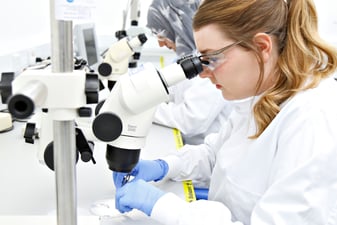Inflammatory bowel disease (IBD) is rising in prevalence across the globe, as the number of individuals diagnosed with the condition has increased by 95% since 1990.1 Despite the recent scientific advances in therapies for IBD, including ulcerative colitis and Crohn’s disease, there are still persistent unmet medical needs due to the complexity and chronic nature of these conditions. There are many challenges when it comes to managing IBD effectively, due to its multifaceted nature. Unlike single-pathway diseases, IBD can be triggered by a variety of different causes, and even a mix of more than one, including environmental factors, imbalances within the gut, genetics and more. Researchers have been hard at work expanding the therapeutic armamentarium2 for IBD and related issues, but there still seems to be a ‘therapeutic ceiling3;’ a plateau of clinical remission rates that persists around 20-30%. The existence of this plateau calls for alternative strategies in drug development to attack the problem.
Since IBD involves many pathways, targeted approaches need to be especially precise and innovative. This poses the question, which REPROCELL is in a unique position to answer: How can new drug discovery models accelerate the development of treatments, and attempt to break the therapeutic ceiling?
Translating Innovation: The Role of Collaborative Programs
In January 2024, The Crohn’s and Colitis Foundation partnered with Evotec SE, a life science company, to help drug discovery progress for two drug targets ‘stemming from cutting-edge academic research for inflammatory bowel disease (IBD) which includes Crohn’s disease and ulcerative colitis.’ 4 This collaboration brings together academic research and therapeutic development, because while academic labs can identify new potential drug targets, they can lack the resources needed to advance the discoveries further. The IBD Therapeutics Incubator, part of the Foundation’s IBD Ventures program, progresses projects aimed at fibrosis – a build-up of scar tissue in the intestinal wall 5 – and restoring intestinal barrier function to combat chronic inflammation caused by leaky gut 6. This initiative exemplifies a partnership that will address unmet needs in IBD care, hopefully allowing progress to be made past the therapeutic ceiling.
Such partnerships are central to future innovation in IBD research. As the range of treatment options increases, so too does the need to select the optimum treatment for identifiable patient cohorts and to better address problems such as fibrosis and barrier disruption, where therapeutic options are thin on the ground. Moreover, as the cost of translating innovative therapies to the clinic grows, the preclinical methods used to predict clinical success and model patient outcomes are put under the spotlight.
The Role of Human Tissue Models in Redefining Success
One of the many benefits of using fresh IBD tissues in studies is their ability to mimic responses that one would see from a human patient, thereby improving clinical outcomes. IBD is a multifaceted condition, meaning that it can be extremely difficult to properly replicate it using in vivo animal models. Additionally, because of the number of differences between human and animal tissues, in particular the gastrointestinal and immune systems, it makes animal models unreliable for these types of studies.7 This means that both fresh and bioengineered IBD tissues function better in non-clinical studies, as they can mimic patient-relevant responses and improve the predictions of clinical outcomes. While there is a margin of error, as there is for everything, it is reduced using human-relevant test systems.8
One of the ex vivo models for IBD studies is the Ussing chamber, which was invented in 1950 to better understand the mechanisms behind active transport in membranes such as intestinal tissue. Now, it is commonly used in studies to ‘evaluate ion transport in tissues such as the gut mucosa.’9 Despite the different methods that can be used for studying the gut barrier, Ussing chambers are the gold standard for gauging the epithelial barrier function in human intestinal tissue. Other methods include everted gut sacs and microfluidic gut-on-a-chip.10
Fresh IBD tissues can be made available for research in two ways, always with the express consent of the patient. One source is elective or emergency surgery to remove the area of the intestine severely affected by the disease. Surgery of this nature is clearly a last resort, should drug treatment options have failed to sufficiently control the disease. A second source of fresh IBD tissue is via the donation of small pinch biopsies during endoscopy procedures. This route offers a small number of biopsies from patients who often have earlier stage disease and may even be drug treatment naïve. In both cases, considerable expertise in logistics, dissection and experimentation on human tissue is required to generate valuable data in a rapid fashion soon after the procedures. Nonetheless, this type of approach has been used at various points through the drug discovery process, from target discovery through to preclinical proof of concept, to track biomarkers of disease status11 and even during clinical trials to monitor responses. Such fresh tissues retain the disease phenotype and reflect the expression of inflammatory cytokines.12 While human tissue has its benefits, as with many in vitro systems, it is limited by the duration of the experiments. This is where a new and innovative approach of bioengineered tissues can bridge the gap to longer duration studies.
In addition to fresh tissue, 3D bioengineered models are helping make headway in IBD studies, as they can closely mimic the structure of human tissue, with experiments of longer duration. 3D models are extremely versatile and allow researchers to study disease mechanisms and test combination therapies to target multiple pathways, thereby leading to the highest chance of success. REPROCELL is proud to offer the most advanced commercially available bioengineered model of IBD, to allow investigations into inflammation, barrier integrity and fibrosis. Many success stories exist at the behest of bioengineered tissue, through the mimicry of human responses to potential therapies.13
Overcoming the Therapeutic Ceiling: Targeting Multi-Pathway Disease
With such a complex condition such as IBD, potential solutions need to target multiple cytokines to sufficiently decrease inflammation and other symptoms. Some treatments for IBD do more than just help the gut; they also work on other immune-related conditions because they target multiple signals within the immune system. Ustekinumab, a monoclonal antibody, is a dual-pronged approach for IBD and psoriatic arthritis. It blocks two key immune system messengers, IL-12 and IL-23, both of which drive inflammation. Through targeting these two proteins, the drug helps with IBD and also conditions such as psoriatic arthritis, where the immune system attacks the skin and joints.14
Another example of a multi-pathway approach is via the use of Janus kinase inhibitors (JAKis), which are a group of orally administered small molecule drugs that modulate multi-cytokine signalling pathways to mediate immune responses that are triggered in IBD. Additionally, combination JAK inhibition targets more than just inflammation in the gut, and can target the inflammation pathways that may go awry in joints, making it another multi-pathway treatment15 ,16. These treatments are worth exploring because they address the broader immune response rather than just focusing on one piece of the puzzle.
In the future of drug discovery and development testing for IBD, the need to explore combination therapies and how human tissue models can test strategies in preclinical stages is more important than ever. Since it involves many immune signals working together, a combination of drugs that can block several pathways at once, might offer a more comprehensive way to reduce inflammation and prevent long-term damage such as fibrosis.
The Future of IBD Drug Development
The future of IBD dug development lies in collaborative programs like the IBD Therapeutics Incubator, a focus on combination therapies that target multiple immune pathways, and leveraging both advanced human and bioengineered tissues to optimise drug discovery. REPROCELL stands at a unique intersection between both approaches, providing contract research services for both 3D and fresh IBD assays. We address the challenges presented by the therapeutic ceiling by utilising both forms of advanced drug discovery models so we can replicate the complexity of IBD pathways. By integrating these cutting-edge approaches, we aim to deliver better outcomes for patients living with IBD. REPROCELL is more than happy to help you with your studies and we’re looking forward to hearing from you!
References
- Johnson TO, Akinsanmi AO, Ejembi SA, Adeyemi OE, Oche JR, Johnson GI, Adegboyega AE. Modern drug discovery for inflammatory bowel disease: The role of computational methods. World J Gastroenterol. 2023 Jan 14;29(2):310-331. doi: 10.3748/wjg.v29.i2.310. PMID: 36687123; PMCID: PMC9846937.
- Danese S, Solitano V, Jairath V, et al. The future of drug development for inflammatory bowel disease: the need to ACT (advanced combination treatment) Gut 2022;71:2380-2387.
- Breaking the therapeutic ceiling in drug development in ulcerative colitis. Alsoud, Dahham et al. The Lancet Gastroenterology & Hepatology, Volume 6, Issue 7, 589 - 595
- Peifer, Rachel. “Crohn’s & Colitis Foundation and Evotec Enter Agreement to Advance Drug Discovery for Novel IBD Therapies.” Crohn’s & Colitis Foundation, 9 Jan. 2024, www.crohnscolitisfoundation.org/crohns-colitis-foundation-and-evotec-enter-agreement-to-advance-drug-discovery-novel-ibd-therapies.
- D’Alessio, S., Ungaro, F., Noviello, D. et al. Revisiting fibrosis in inflammatory bowel disease: the gut thickens. Nat Rev Gastroenterol Hepatol 19, 169–184 (2022). https://doi.org/10.1038/s41575-021-00543-0
- Camilleri M. Leaky gut: mechanisms, measurement and clinical implications in humans. Gut 2019;68:1516-1526.
- Joshi, A., Soni, A. & Acharya, S. In vitro models and ex vivo systems used in inflammatory bowel disease. In vitro models 1, 213–227 (2022). https://doi.org/10.1007/s44164-022-00017-w
- Johnson TO, Akinsanmi AO, Ejembi SA, Adeyemi OE, Oche JR, Johnson GI, Adegboyega AE. Modern drug discovery for inflammatory bowel disease: The role of computational methods. World J Gastroenterol. 2023 Jan 14;29(2):310-331. doi: 10.3748/wjg.v29.i2.310. PMID: 36687123; PMCID: PMC9846937.
- Joshi, A., Soni, A. & Acharya, S. In vitro models and ex vivo systems used in inflammatory bowel disease. In vitro models 1, 213–227 (2022). https://doi.org/10.1007/s44164-022-00017-w
- Olga Biskou, Amaia Jauregi-Miguel, Chapter 3 - Measuring intestinal permeability in celiac disease ex vivo, using Ussing chambers, Methods in Cell Biology, Academic Press, Volume 179, 2023, Pages 21-38, https://doi.org/10.1016/bs.mcb.2022.12.005.
- Liu et al., Inflammatory bowel disease biomarkers. Medicinal Research Reviews, Volume 42, Issue 5, September 2022, Pages 1856-1887. https://doi.org/10.1002/med.21893
- Podolski et al. Correlation of ex vivo cytokine secretion profiles with scoring indices in ulcerative colitis. European Journal of Clinical Investigation, Volume 53, issue 12, December 2023. https://doi.org/10.1111/eci.14070
- Terrence T. Roh, Ying Chen, Harry T. Paul, Chengchen Guo, David L. Kaplan, 3D bioengineered tissue model of the large intestine to study inflammatory bowel disease, Biomaterials, Volume 225, 2019, https://doi.org/10.1016/j.biomaterials.2019.119517.
- https://crohnsandcolitis.org.uk/media/yhrdwfc0/ustekinumab_ed_1c_2021.pdf
- Honap S, Agorogianni A, Colwill MJ, et al. JAK inhibitors for inflammatory bowel disease: recent advances. Frontline Gastroenterology 2024;15:59-69.
- Harris C, Cummings JRF. JAK1 inhibition and inflammatory bowel disease. Rheumatology (Oxford). 2021 May 5;60(Supple 2):ii45-ii51. doi: 10.1093/rheumatology/keaa896. PMID: 33950226; PMCID: PMC8098109.





.jpg?width=1000&height=562&name=Untitled%20design%20(5).jpg)

